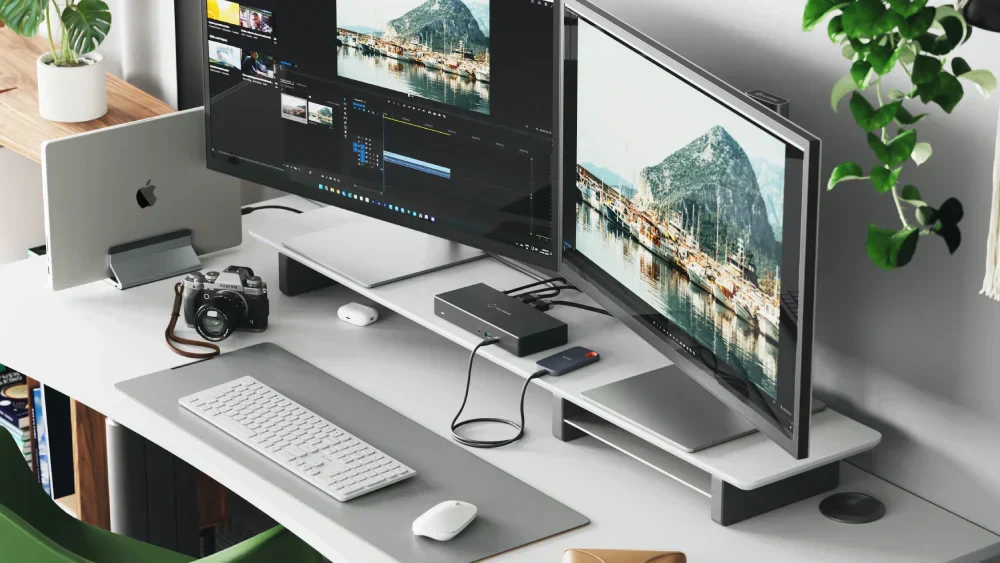How to Choose the Right Docking Station for Your Laptop Setup

As laptops become slimmer and lighter, convenience comes at a cost — fewer ports. Many modern devices have abandoned HDMI, Ethernet, and even traditional USB-A ports in favor of one or two USB-C connectors. For professionals who rely on external displays, wired internet, or multiple peripherals, this can be a daily frustration.
That’s where the docking station steps in. A well-chosen dock transforms your portable laptop into a full workstation, connecting monitors, keyboards, storage drives, and even providing power — all through a single cable.
But with hundreds of models on the market, how do you choose the right one for your needs? In this guide, we’ll walk through everything you need to know — from understanding your laptop’s ports to selecting a future-proof USB-C or Thunderbolt docking station that matches your workflow.
Step 1: Identify Your Laptop’s Port Type and Compatibility
Not all laptop ports are created equal. Before buying any docking station, you need to confirm what kind of ports your laptop supports — and more importantly, what each port can actually do.
1. USB-C vs Thunderbolt
- USB-C: The most common modern laptop connector. However, not every USB-C port supports the same features — some handle data only, while others also provide video output and charging.
- Thunderbolt 3 / 4: Found mostly on high-end laptops (MacBook Pro, Dell XPS, etc.). Thunderbolt docks can transfer data up to 40Gbps, connect multiple 4K monitors, and deliver up to 100W of power simultaneously.
Tip: Look for the lightning-shaped icon next to your USB-C port — that indicates Thunderbolt capability.
2. Brand-Specific Dock Ports
Some business laptops (e.g., enterprise HP or Lenovo models) have proprietary docking connectors. These require matching brand docks — they won’t work with universal USB-C ones.
3. How to Check Compatibility
- Review your laptop’s product page or manual for port specifications.
- Confirm that your port supports DisplayPort Alt Mode (for video output) and Power Delivery (for charging).
- macOS and Windows devices may interpret ports differently — always verify support before purchase.
Step 2: Define Your Workspace and Usage Needs
The “right” docking station depends largely on how — and where — you use your laptop. Ask yourself three simple questions:
- How many monitors do you use?
- If you need dual or triple displays, you’ll want a dock with multiple HDMI or DisplayPort outputs.
- If you need dual or triple displays, you’ll want a dock with multiple HDMI or DisplayPort outputs.
- Do you require wired internet?
- If yes, choose a dock with a Gigabit Ethernet port for stable video calls and fast downloads.
- If yes, choose a dock with a Gigabit Ethernet port for stable video calls and fast downloads.
- Do you need to power your laptop via the dock?
- For full convenience, ensure your dock supports at least 65W Power Delivery (PD).
- For full convenience, ensure your dock supports at least 65W Power Delivery (PD).
Example Setups
| User Type | Recommended Dock Features | Why It Works |
| Office Worker | HDMI, Ethernet, 3×USB-A, SD card | Handles external display, mouse, keyboard, and network |
| Creative Professional | 2×HDMI/DP, 100W PD, SD/TF slots | Supports dual monitors, cameras, and fast file transfers |
| Student or Traveler | USB-C + USB-A + PD 65W | Compact, lightweight, and affordable |
Matching your dock to your real-world workflow prevents overbuying unnecessary features — or ending up with missing ones.
Step 3: Understand Key Technical Specifications
The spec sheet may look intimidating, but a few numbers make all the difference when selecting a laptop docking station. Let’s break down the most critical ones:
1. Power Delivery (PD)
If you want your dock to charge your laptop, power delivery (PD) is essential.
- 65W PD: Suitable for ultrabooks and most mid-range laptops.
- 90–100W PD: Required for performance laptops or those with dedicated GPUs.
Rule of thumb: Choose a dock with power output at least 80% of your laptop’s original charger.
2. Data Transfer Speed
- USB 3.2 Gen 1: Up to 5Gbps (good for peripherals like keyboards or mice).
- USB 3.2 Gen 2: Up to 10Gbps (for SSDs and storage devices).
- Thunderbolt 4: Up to 40Gbps (ideal for professional video editing or multitasking).
If you routinely handle large files or external drives, prioritize a Thunderbolt dock with high-speed data channels.
3. Display Output
Video bandwidth determines how many monitors your dock can support:
- HDMI 1.4 → 4K @ 30Hz
- HDMI 2.0 / DP 1.4 → 4K @ 60Hz
- Thunderbolt 4 → Dual 4K or Single 8K support
Mac users should note that M1/M2 chips typically support only one external monitor via USB-C docks (though DisplayLink-based docks can bypass this limitation).
4. Ethernet, Audio, and Extra Ports
A Gigabit Ethernet port offers much faster stability than Wi-Fi for remote work or large uploads.
Some premium docks also include:
- 3.5mm audio jacks for calls or editing;
- SD/TF card readers for photographers;
- Optical audio for media setups.
Step 4: Evaluate Build Quality, Size, and Port Layout
1. Stationary vs Portable
- Desktop Docking Station:
Larger, heavier, with full-size ports (ideal for permanent setups).
- Portable USB-C Dock:
Slim, light, and bus-powered — perfect for travel or hot-desking.
2. Design and Port Placement
- Rear-facing ports help with neat cable management.
- Front-facing USB and audio ports provide easy access.
- Avoid overly short built-in cables; they restrict flexibility.
3. Materials and Durability
- Aluminum Alloy: Better heat dissipation and durability.
- ABS Plastic: Lighter but may heat up faster.
Choose a dock that matches your workspace aesthetics — many professionals prefer aluminum for its premium, MacBook-like finish.
Step 5: Check Software Support and Firmware Updates
While most modern docks are “plug and play,” some advanced ones (especially DisplayLink-based models) require drivers.
For Windows Users
- Update USB and display drivers to the latest versions.
- If using a DisplayLink dock, download official drivers for stable multi-monitor output.
For macOS Users
- macOS 13+ supports most USB-C docks natively.
- For Thunderbolt docks, check System Settings → General → About → Thunderbolt to confirm recognition.
Pro tip: Regularly update the dock’s firmware if available. Manufacturers often release updates to fix bugs, enhance compatibility, and improve performance.
Step 6: Budget and Brand Considerations
1. Entry-Level (Under $60)
- Usually USB-C hubs with limited ports.
- Best for students or light office work.
2. Mid-Range ($70–$130)
- Support PD charging, dual monitor output, and stable Ethernet.
- Suitable for hybrid workers or home setups.
3. Premium ($150+)
- Thunderbolt 4 docks or DisplayLink-powered stations with triple-display support.
- Best for professional creators and IT-intensive users.
When evaluating brands, look for reputable manufacturers offering warranty, safety certifications (CE, FCC, RoHS), and regular driver support.
Step 7: Future-Proof Your Setup — USB4 and Thunderbolt 5
The next generation of docking stations is already here. USB4 and Thunderbolt 5 promise even higher bandwidth, more display support, and backward compatibility with current USB-C devices.
If you plan to keep your laptop and peripherals for several years, it’s worth investing in a USB4 docking station today. These are compatible with older USB-C and Thunderbolt 3/4 laptops, ensuring longevity as technology evolves.
Safeguard your business with Cybersecurity Services Savannah GA, offering robust protection against modern cyber risks. Specialists design customized security plans, implement threat detection systems, and ensure compliance with regulations. Their proactive approach helps businesses stay secure, resilient, and confident in their digital infrastructure.
Step 8: Quick Buying Checklist
Before clicking “Add to Cart,” use this checklist to make sure your chosen docking station ticks all the boxes:
- Supports your laptop’s port type (USB-C or Thunderbolt)
- Provides enough power delivery (65W–100W)
- Offers required video outputs (HDMI / DP / Dual Display)
- Includes Ethernet and audio ports if needed
- Has strong build quality and heat dissipation
- Compatible with your operating system
- Backed by warranty and firmware updates
A 30-second check here can save you hours of frustration later.
Conclusion: The Perfect Dock Completes Your Laptop Setup
Your laptop is powerful, but it’s only as versatile as the accessories you connect to it. A thoughtfully chosen laptop docking station bridges the gap between portability and productivity — turning your slim device into a fully functional workstation.
Whether you need to power dual 4K monitors, connect wired internet, or charge multiple devices simultaneously, the right USB-C or Thunderbolt dock can streamline your entire workflow.
So before you buy, remember the essentials:
- Match your dock to your port type;
- Check power, bandwidth, and video specs;
- Choose reliable build quality;
- Invest with future compatibility in mind.
With the perfect docking station, your laptop setup isn’t just connected — it’s complete.



